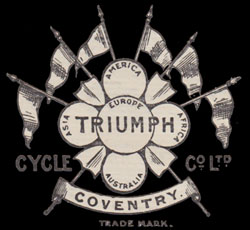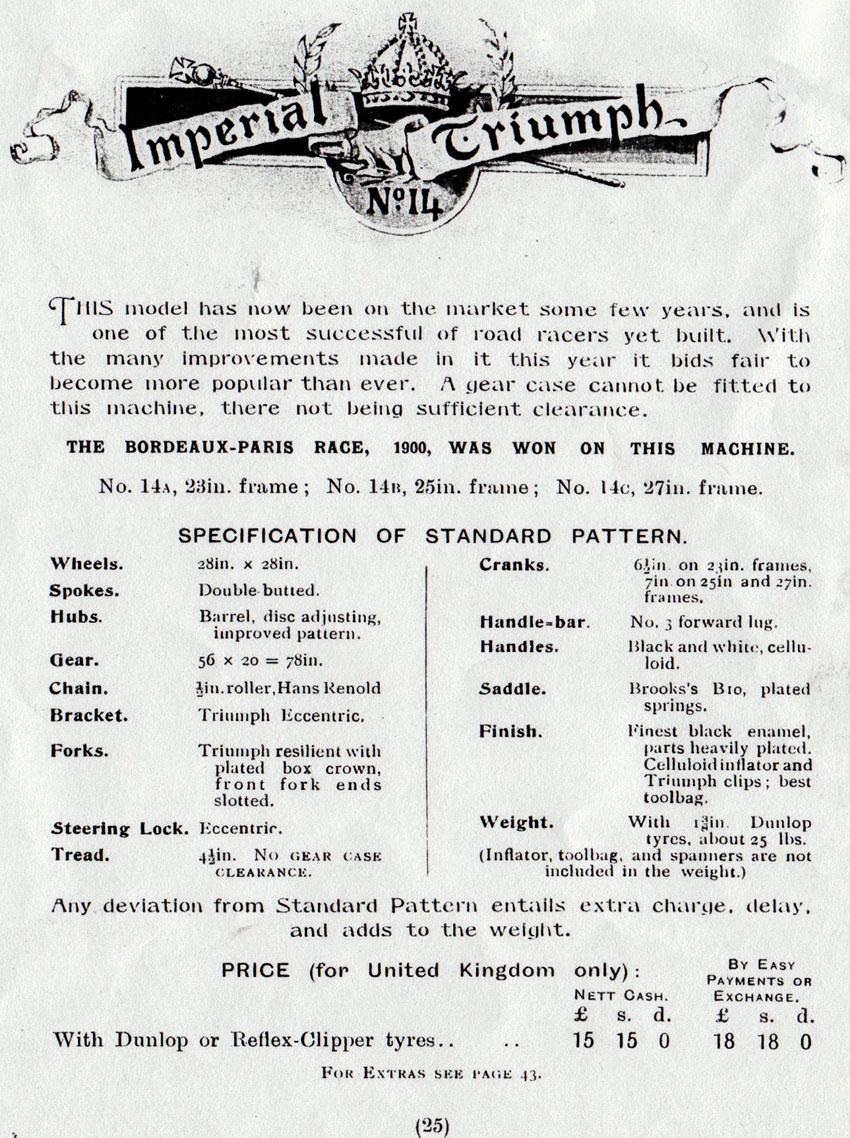
Dear Sirs, The No. 14 road racer you built for me is out and out the best machine I have ever ridden, and I have cycled since 1892. It is a grand hill-climber, and runs both noiselessly and easily. I shall have great pleasure in recommending your machines to my friends, confident that they will give every satisfaction.
Yours sincerely, T.H. Addison
– 1901 Triumph sales catalogue
With funding provided by the Dunlop Pneumatic Tyre Co as well as their own families, Siegfried Bettmann and Moritz Schulte started producing their first Triumph-branded bicycles in 1889, at their new factory in Coventry. They also initiated a factory in their native Nuremberg, Germany, in 1896.
German champion Josef Fischer rode a No 14 Imperial Triumph Road Racer to win the Bordeaux-Paris race in 1900. This success gave a serious boost to Triumph sales.
From 1898 Triumph started developing motorcycles and the first was produced in 1901 – a bicycle fitted with a Minerva engine. They sold 500 of these in 1903. By 1905, the Triumph motorcycle was completely their own design, establishing them immediately as a major motorcycle manufacturer.
But, as the new century dawned, with cars and motorcycles not yet dominant, this fast bicycle was Triumph’s top machine and still king of the road.
The one you see here is the only survivor.

1900 ‘No 14B’ Imperial Triumph Road Racer
25″ Frame
28″ Wheels
Frame No 23738
(Now sold)

According to the catalogue, the 25″ frame size designates this one as a ’14B.’



This road racer is a fixed wheel machine, and the chainwheel is very distinctive.

The handlebars are a’No 3 Forward Lug.’

The Triumph name is etched into the metal below the lamp bracket.










HISTORY of TRIUMPH CYCLE Co LTD


Siegfried Bettmann was a German immigrant from Nuremberg who started work in England with the White Sewing Machine Company as a translator helping to sell sewing machines. Siegfried was very aware of the public enthusiasm for bicycles, so in 1884 he founded the company “S. Bettmann & Co”, to sell bicycles made by the Birmingham firm, William Andrews, but labelled under his own name. In 1886 Siegfried changed the name of his company to the “Triumph Cycle Company Limited”, as he considered the trade name Triumph to be a positive and exciting name that was readily understood in a number of languages. His business flourished.
In 1887, Siegfried Bettmann was joined by the engineer Mauritz Johan Schulte, also from Nuremburg, and they set their minds to the production of their own bicycles, which began at their Coventry factory in 1889. It was in the late 1880′s that the internal combustion engine began to develop into a more reliable and useful power source, so Bettmann and Schulte thought about adding motor powered bicycles to their range of products. At first, they considered building the Hildebrand & Wolfmuller motorcycles under license, and imported one in 1895 for testing. They also considered building the Beeston Humber motorcycle, but both these plans came to nothing, so they decided to produce their own motorcycle.
 In 1902, the ‘No 1’ (as their first motorcycle was known) was built. It was designed by Mauritz Shulte, using a strengthened bicycle and a 2.25bhp one-cylinder Belgian Minerva engine driving the rear wheel by a belt from the engine crankshaft. The bicycle pedals, chain and crank were retained to both start the engine and provide power in the event of engine failure. The Minerva engine was chosen as it was one of the best available. These powered bicycles proved a great success so their next challenge was to build a motorcycle of entirely their own design.
In 1902, the ‘No 1’ (as their first motorcycle was known) was built. It was designed by Mauritz Shulte, using a strengthened bicycle and a 2.25bhp one-cylinder Belgian Minerva engine driving the rear wheel by a belt from the engine crankshaft. The bicycle pedals, chain and crank were retained to both start the engine and provide power in the event of engine failure. The Minerva engine was chosen as it was one of the best available. These powered bicycles proved a great success so their next challenge was to build a motorcycle of entirely their own design.
In 1905, the first all British completely Triumph designed and built motorcycle was built. It was designed by Mauritz Schulte and Charles Hathaway, who was the Triumph works factory manager and an enthusiastic motorcyclist and gifted engineer. The new Triumph motorcycle had a 3 bhp 363cc side-valve engine with, unusually, the crankshaft mounted on ball bearings. It was also equipped with alternator ignition (with an option of the Simms-Bosch magneto for an extra £5). The motorcycle could cruise at 35 mph and top speed of 45 to 50mph. They produced 250 in their first year.
In the following years Triumph continued to develop their design, always testing and proving each idea to ensure good reliability. In 1906 they added a new front fork design and by 1908 the engine had a displacement of 476cc with a power output of 3.5bhp and a variable pulley system to allow the crankshaft to wheel ratio to be varied between 4:1 and 6:1 allowing the rider to tackle inclines as well as get speed on the flat. To change the ratio, the rider had to stop, screw the pulley wheel in or out, adjust the length of the belt but adding or removing short segments of the belt, before they could continue. Not the sort of change one would wish to do regularly!
The good reliability and handling of Triumph motorcycles brought success on the racing track. Jack Marshal won the 1908 Isle of Man TT on a Triumph and a well known observation, “Eight Triumph’s started, and eight finished…” helped reinforce Triumph’s reputation for reliability. In 1910, Triumph introduced a small, foot operated wet drum clutch that allowed the engine to run freely when the bike was stationery. This allowed the engine to be started whilst it was on it’s stand, rather than having to bump start the engine whilst pedalling. Triumph were now building thousands of machines a year and their reputation was continuing to grow.
In 1911, Mr. Ivan Hart-Davies rode a specially equipped Triumph from Land’s End to John O’Groats (900 miles) in just 29 hours and 12 minutes; an average of 30mph. This broke the previous record of 6 days created by A. E. Catt. Remember, macadamized roads where only just patented in 1901, so most roads at this time would be very rough and there was very limited suspension!
 At the outbreak of the First World War, Triumph were producing their type A, which had an output of 4bhp from it’s 550cc engine. From late 1914, the Type H was bought in large quantity by the British Government to equip the army despatch riders and by the end of the war in November 1918, over 30,000 had been produced for military service. The Type H had a chain driven primary drive and a belt driven final drive. It used a Sturmey-Archer three-speed hand operated gearbox, a multi-plate clutch and a kick-starter. It was this motorcycle that won the nickname ‘The Trusty’ through it’s great reliability under difficult conditions. It was also the first Triumph motorcycle not to be equipped with pedal power.
At the outbreak of the First World War, Triumph were producing their type A, which had an output of 4bhp from it’s 550cc engine. From late 1914, the Type H was bought in large quantity by the British Government to equip the army despatch riders and by the end of the war in November 1918, over 30,000 had been produced for military service. The Type H had a chain driven primary drive and a belt driven final drive. It used a Sturmey-Archer three-speed hand operated gearbox, a multi-plate clutch and a kick-starter. It was this motorcycle that won the nickname ‘The Trusty’ through it’s great reliability under difficult conditions. It was also the first Triumph motorcycle not to be equipped with pedal power.
In 1919, Bettmann wanted to broaden the range of items manufactured by Triumph. Schulte disagreed, so sadly left the company, ending the first phase of the company.
{credits: www.scripophily.net for the 1898 Triumph Cycle Co certificate; short history from John’s Model H website – http://triumphmodelh.com/History.html]








INTRODUCTION TO TRIUMPH
from 1910 Triumph Catalogue









SHORT VIDEO: RIDING THE 1900 TRIUMPH ROAD RACER
1900_Triumph






LA VIE AU GRAND AIR, 1901
BORDEAUX-PARIS






























 In 1902, the ‘No 1’ (as their first motorcycle was known) was built. It was designed by Mauritz Shulte, using a strengthened bicycle and a 2.25bhp one-cylinder Belgian Minerva engine driving the rear wheel by a belt from the engine crankshaft. The bicycle pedals, chain and crank were retained to both start the engine and provide power in the event of engine failure. The Minerva engine was chosen as it was one of the best available. These powered bicycles proved a great success so their next challenge was to build a motorcycle of entirely their own design.
In 1902, the ‘No 1’ (as their first motorcycle was known) was built. It was designed by Mauritz Shulte, using a strengthened bicycle and a 2.25bhp one-cylinder Belgian Minerva engine driving the rear wheel by a belt from the engine crankshaft. The bicycle pedals, chain and crank were retained to both start the engine and provide power in the event of engine failure. The Minerva engine was chosen as it was one of the best available. These powered bicycles proved a great success so their next challenge was to build a motorcycle of entirely their own design. At the outbreak of the First World War, Triumph were producing their type A, which had an output of 4bhp from it’s 550cc engine. From late 1914, the Type H was bought in large quantity by the British Government to equip the army despatch riders and by the end of the war in November 1918, over 30,000 had been produced for military service. The Type H had a chain driven primary drive and a belt driven final drive. It used a Sturmey-Archer three-speed hand operated gearbox, a multi-plate clutch and a kick-starter. It was this motorcycle that won the nickname ‘The Trusty’ through it’s great reliability under difficult conditions. It was also the first Triumph motorcycle not to be equipped with pedal power.
At the outbreak of the First World War, Triumph were producing their type A, which had an output of 4bhp from it’s 550cc engine. From late 1914, the Type H was bought in large quantity by the British Government to equip the army despatch riders and by the end of the war in November 1918, over 30,000 had been produced for military service. The Type H had a chain driven primary drive and a belt driven final drive. It used a Sturmey-Archer three-speed hand operated gearbox, a multi-plate clutch and a kick-starter. It was this motorcycle that won the nickname ‘The Trusty’ through it’s great reliability under difficult conditions. It was also the first Triumph motorcycle not to be equipped with pedal power.


























